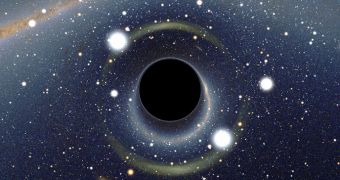Researchers studying the development of supermassive black holes have recently determined that the enormous structures experienced the highest amount of growth about 1.2 billion years after the Big Bang, when the Universe was only a fraction of its current age.
Previous studies of the phenomenon indicated that the growth spur took place 2 to 4 billion years after the Cosmos appeared, but this investigation refines those results even further.
Since black holes cannot be detected directly, astronomers look for them by scanning the night sky for signs of massive radiation plumes. Some of these objects are emitted when superheated gas falls through the event horizon of a black hole.
This is the process through which astronomers believe these structures grow. The process functions in stages, where active periods of matter accretion are followed by periods of relative inactivity.
In an interesting twist, the new study uncovered that the oldest supermassive black holes are also the ones that grow most rapidly. These objects are 1 million to 10 billion larger in size than our Sun, Science Blog reports.
The new study was conducted by professor Hagai Hetzer and his research student Benny Trakhtenbrot, who are both based at the Tel Aviv University (TAU), in Israel. Their work will be detailed in an upcoming issue of the esteemed Astrophysical Journal.
Observations of black holes were conducted indirectly, using two of the largest telescopes in the world, the Mauna Kea, Hawaii-based Gemini North, and the Cerro Paranal, Chile-based Very Large Telescope (VLT), which is operated by the European Southern Observatory (ESO).
An important discovery in the research was that the earliest black holes began growing impressively fast when the Universe was only several hundred million years old.
Therefore, these objects must be related to the earliest stars. Existing theories show that those cosmic fireballs – the first ever to form after the Big Bang – were very massive.
Black holes can only form from massive stars, when the objects reach the end of their burning cycles. Powerful supernova events then take place, which force the inner core of the stars to implode.
Given the size of the stars, only a small portion of the supernova events resulted in neutron stars. Whereas black holes can grow indefinitely, neutrons stars cannot.
As they grow beyond a certain point, they again implode, and collapse to form a black hole. The new study provides another piece of the puzzle that is the early Universe, as well as a better understanding of how the Cosmos evolved shortly before and long after the end of the reionization epoch.

 14 DAY TRIAL //
14 DAY TRIAL //